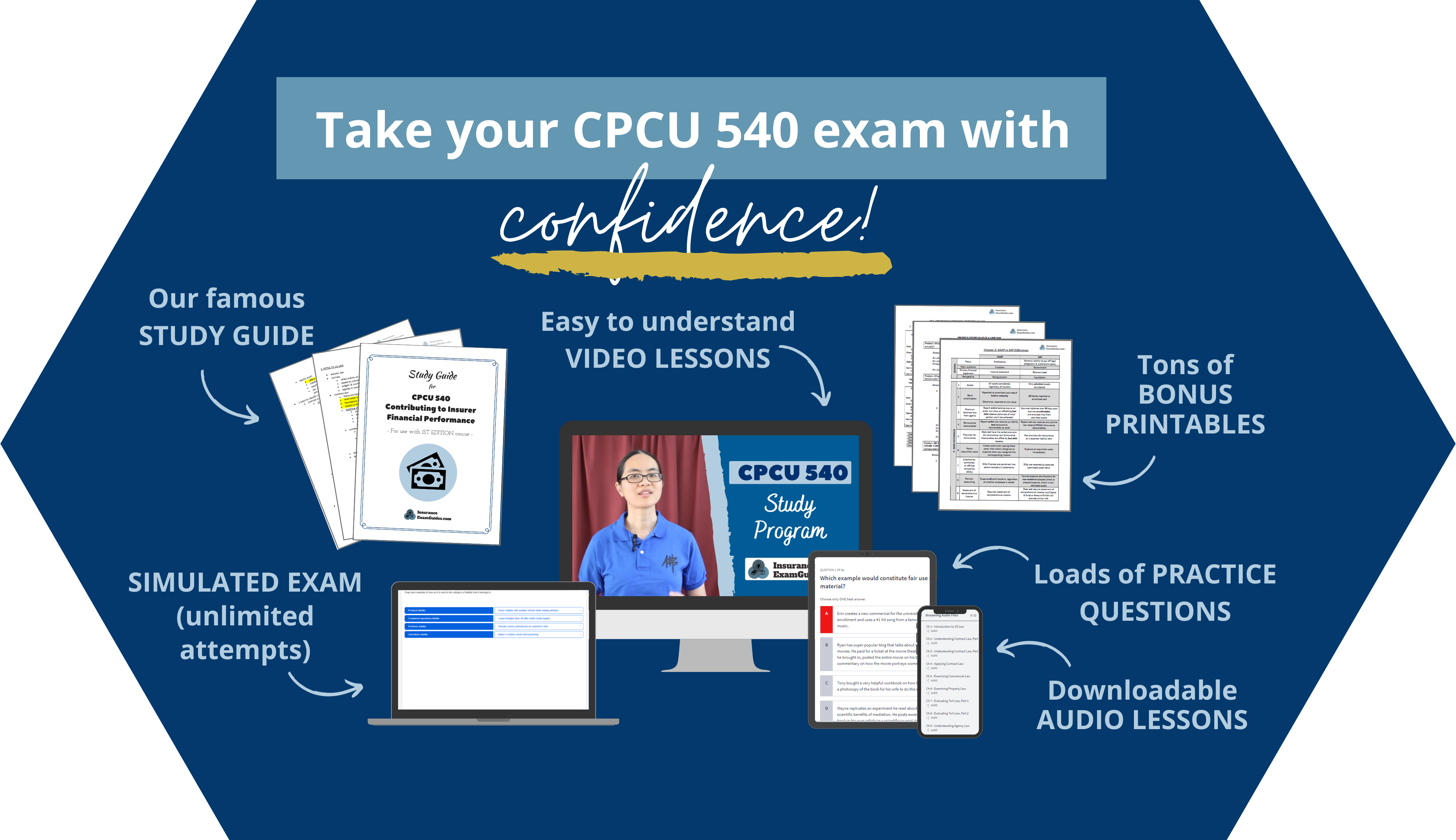Summary of changes:
- Chapter 1 has a lot of new content
- Chapter 3 (GAAP analysis) was removed
- Chapter 7 (financial markets) was removed
- Very few practice quiz questions
- Significant changes to simulated exam
Exam information:
- For third quarter (Q3) test window: Exam is based on the expiring version of the course, CPCU 540: Impacting the Bottom Line of Insurance Financials. The last day to test on this version of the exam is September 15, 2023.
- For subsequent test windows: Exam will be based on the new version of the course, CPCU 540: Contributing to Insurer Financial Performance.
Details of overall changes:
1) Improved visual look: The new interface is more colorful and visually appealing.
2) Improved word choice: The wording in the new courses is much simpler and easier to understand than before.
A big complaint about prior courses was that the wording was too verbose and used overly complex word choices that were not necessary. That made it more difficult to follow along and stay attentive, but the newer course is much better about this.
3) Majority of content is still text: About 90% of the course content is still text-based, meaning you still have to do a lot of reading.
This is very surprising because The Institutes had stated on their CPCU FAQ page that “the learning experience is being updated to match the needs of today’s busy adult learner—including more videos and interactions to help students acquire and retain the skills they need to be leaders.” We did not find any interactive modules within the assignments themselves, and the practice quizzes & practice exam did not appear to have any changes. The only portion of the course that included a new style of activity was the simulated exam, which we discuss in further detail in #5 below.
On a side note regarding the video content: you do have the option to turn on captions and change the speed of the video. We found the videos much easier to watch at a faster speed and with the captions on.
4) Organization of topics is not as intuitive: In the newer course, the topics aren’t grouped together as logically as how they are grouped in the current expiring course.
In the expiring edition, most related topics were grouped together into their own chapters, but the new course breaks up some of those topics so that they discussed here and there over more than one chapter.
Also, the order in which the concepts are introduced is not as ideal. In the expiring course, earlier chapters helped you better understand the chapters that followed. In the newer course, however, there were multiple instances where a topic was presented at one point, but then another topic that would have been helpful for understanding the first topic doesn’t show up until later.
5) Very limited number of practice questions: There are very few practice questions in the chapter quizzes.
The average number of questions per chapter was around 9, and some had as few as 6. We tried retaking the quizzes to see if there were other questions being drawn from a question bank, but all the questions were exactly the same as the first take.
6) Simulated exam:
In the newer course, the simulated exam uses the same interface as the actual exam, so it does a much better job of mimicking the true exam experience.
More importantly, the simulated exam included non-multiple choice questions, such as type-in-the-blank, drag-and-drop, and multi-choice multiple choice questions (where more than one of the answer choices is correct). For a detailed discussion of these question types, see our post Virtual exam information.
We did email The Institutes to inquire if the actual exam will include these new question formats, and they responded that “No changes have currently been made to designation credentialing exams or the corresponding grade reports.”
One more thing worth noting about the simulated exam is that once you finish the test, review what you got wrong, and close out of it, you can no longer access the exam attempt again to re-review the questions.
7) Overall focus of the course: Instead of explaining accounting & finance in general and then pointing out how the insurance industry differs, the new course focuses on policyholders surplus and ties nearly everything else back to that.
In the expiring course, the basic approach of the course was to explain how a finance or accounting concept works in general, then explain how it might apply differently in the insurance industry. Because of that, the course felt more like a finance & accounting course that had side commentary on insurance, rather than being an insurance-centric course.
In the new course, the main emphasis is on clearly on understanding policyholders surplus, and all the other content is always tied back to that. Because of this, the new course does feels much more insurance-specific, and does not place as high priority on mastering the basics of accounting & business finance.
This means that what you will get out of each course feels quite different. On one hand, the expiring course will provide you with broad knowledge on finance & accounting that can be incredibly useful, as there are many contexts and industries where you could apply what you have learned. However, the new course gives you much more specialized insurance-based knowledge; if you are planning to stay in the insurance industry, the latter course does a better job of helping you understand how to improve profitability for an insurance company.
List of topics covered:
The list below shows the main topics covered in the expiring course, CPCU 540: Impacting the Bottom Line of Insurance Financials. We have noted what topics have been removed and where the remaining topics appear in the new version of the course in the following manner:
- Sections that do not appear in the newer course with the same level of detail are stricken out (in some cases, minor references to the same topics may still appear in the new course in other places)
- Which chapter each topic can be found under in the new course
- List of new topics that are not covered in the expiring course
Note: We do not provide any guarantees or warranties regarding the accuracy and comprehensiveness of this list.
Chapter 1: [overview of accounting & finance]
Main goals of finance & accounting- Activities and structure of corporate finance departments [chapter 1]
- Financial reporting standards (GAAP vs SAP vs IFRS) [chapter 3]
Chapter 2: [about GAAP financial statements]
- Balance sheet [chapter 3]
- Income statement [chapter 3]
- Statement of changes in shareholders’ equity [chapter 3]
- Cash flow statements [chapter 3]
- Issues unique to insurers [incorporated throughout chapter 3]
Other sources of financial info (SEC forms, annual reports)
Chapter 3: [analyzing GAAP statements]
Vertical analysisTrend analysisRatio analysis
Chapter 4: [about SAP financial statements]
- About SAP [chapter 3]
- SAP accounting equation [chapter 3]
- Differences between GAAP vs. SAP [chapter 3]
- Key components of NAIC Annual Statement (SAP statement) [chapter 3]
- Balance sheet
- Income statement
- Cash flow statement
- Other exhibits & schedules
Chapter 5: [analyzing SAP statements]
- Evaluating capacity [chapters 2 and 4]
- Evaluating liquidity [chapters 2 and 4]
- Evaluating profitability [chapters 2 and 4]
- IRIS ratios [chapters 2 and 4]
- AM Best financial ratings [chapters 2 and 4]
Chapter 6: [time value of money]
- Simple vs compound interest [chapter 2]
- Future value & present value [chapters 2 and 5]
Chapter 7: [financial markets]
Primary financial marketsSecondary financial marketsFinancial intermediaries- Types of financial risks
Role of technology
Chapter 8: [stocks & bonds]
- Elements of a bond [chapter 5]
- Types of bonds [chapter 5]
- Types of stocks [chapter 5]
- Approaches to pricing stocks [chapter 5]
- Annual rate of return [chapter 5]
Chapter 9: [investment portfolio concepts]
- Measuring variability [chapter 5]
- Portfolio management concepts [chapter 5]
- Bond portfolios [chapter 5]
- SAP restrictions on investing [chapter 5]
Chapter 10: [obtaining & managing capital]
- Internal methods of generating/conserving capital [chapters 1 and 6]
- External methods of generating/conserving capital [chapters 1 and 6]
- Shareholder dividends [chapter 6]
Chapter 11: [determining an insurer’s capital requirements]
Financial leverage- Risk-based capital (RBC) [chapter 6]
- NAIC Own Risk & Solvency Assessment (ORSA) [chapter 6]
Economic capital
[new topics in updated course]
- Main goals for insurance companies [chapter 1]
- Factors that determine an insurer’s financial health [chapter 1]
- How underwriting supports an insurer’s goals [chapter 1]
- How claims department supports an insurer’s goals [chapter 1]
- Key areas evaluated by regulators [chapter 4]
Frequently asked questions (FAQ) for IEG products
Which course version is IEG products based on?
- We have updated our study materials to reflect the new course. When clicking the “Buy Now” button, the updated study materials will be added to your shopping cart.
- All students who are enrolled in the expiring version of our study program can request a free upgrade to the updated version by emailing us at info@insuranceexamguides.com
How can existing customers get access to the new study materials?
If you bought a study guide bundle: Use the download link you received in your order confirmation email to download both versions. We have also emailed all prior customers with these same instructions.
If you bought an online study program: Please email us at info@insuranceexamguides.com from the email address you use to sign on to request enrollment in the updated course.
Get a free study plan generator and CPCU progress tracker!
Join our mailing list and score these free tools.
Get your CPCU 540 study materials NOW!
Looking for our printables-only package? Click here.
Why our study programs work
Lots of companies offer study materials too, but here is why our study programs stand out:
See the concepts in action
You will be tested on your ability to apply the concepts to different situations, so we provide plenty of examples to show you how things work.
Less is NOT always more
Some things won't make sense until you have enough background info. We give extra context where you'd need it to fully grasp the material.
Learn AND remember
Besides learning the content, you have to remember it all. Our paid study programs include our famous study guides that make it super easy to refresh your memory.

About your instructor
Insurance Exam Guides (IEG) was founded by Stacy Trinh, CPCU®, who first started her teaching journey at the request of her co-workers who were preparing for their CPCU exams. Because of her reputation as an adept trainer and motivator, Stacy's co-workers had asked her to lead a class. The feedback on her sessions and study materials was overwhelming positive, and her students encouraged her to share what she had to offer with the rest of the CPCU community.
Since then, Stacy created a library of study materials for both CPCU® and AINS® that have helped thousands of students pass their exams. As an accounting major and former claims adjuster, her style of instruction incorporates both a financial and operational perspective that makes her study materials well-rounded. She looks forward to helping many more students continue to succeed, including you!
Disclaimers: The Institutes, CPCU®, and AINS® are trademarks of the American Institute For Chartered Property Casualty Underwriters, d/b/a The Institutes. InsuranceExamGuides.com is not affiliated or associated with The Institutes in any way, and The Institutes do not endorse, approve, support, or otherwise recognize InsuranceExamGuides.com or its products or services. CPCU® and AINS® are registered trademarks of The Institutes. All rights reserved.

